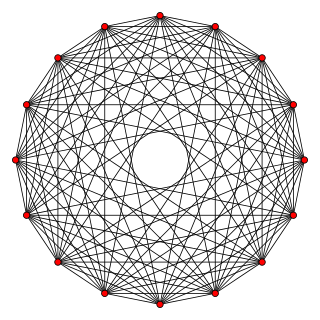Top Qs
Timeline
Chat
Perspective
8-orthoplex
Convex regular 8-polytope From Wikipedia, the free encyclopedia
Remove ads
In geometry, an 8-orthoplex or 8-cross polytope is a regular 8-polytope with 16 vertices, 112 edges, 448 triangle faces, 1120 tetrahedron cells, 1792 5-cell 4-faces, 1792 5-faces, 1024 6-faces, and 256 7-faces.
It has two constructive forms, the first being regular with Schläfli symbol {36,4}, and the second with alternately labeled (checkerboarded) facets, with Schläfli symbol {3,3,3,3,3,31,1} or Coxeter symbol 511.
It is a part of an infinite family of polytopes, called cross-polytopes or orthoplexes. The dual polytope is an 8-hypercube, or octeract.
Remove ads
Alternate names
- Octacross, derived from combining the family name cross polytope with oct for eight (dimensions) in Greek
- Diacosipentacontahexazetton as a 256-facetted 8-polytope (polyzetton), acronym: ek[1]
As a configuration
Summarize
Perspective
This configuration matrix represents the 8-orthoplex. The rows and columns correspond to vertices, edges, faces, cells, 4-faces, 5-faces, 6-faces and 7-faces. The diagonal numbers say how many of each element occur in the whole 8-orthoplex. The nondiagonal numbers say how many of the column's element occur in or at the row's element.[2][3]
The diagonal f-vector numbers are derived through the Wythoff construction, dividing the full group order of a subgroup order by removing individual mirrors.[1]
Remove ads
Construction
There are two Coxeter groups associated with the 8-cube, one regular, dual of the octeract with the C8 or [4,3,3,3,3,3,3] symmetry group, and a half symmetry with two copies of 7-simplex facets, alternating, with the D8 or [35,1,1] symmetry group. A lowest symmetry construction is based on a dual of an 8-orthotope, called an 8-fusil.
Cartesian coordinates
Cartesian coordinates for the vertices of an 8-cube, centered at the origin are
- (±1,0,0,0,0,0,0,0), (0,±1,0,0,0,0,0,0), (0,0,±1,0,0,0,0,0), (0,0,0,±1,0,0,0,0),
- (0,0,0,0,±1,0,0,0), (0,0,0,0,0,±1,0,0), (0,0,0,0,0,0,0,±1), (0,0,0,0,0,0,0,±1)
Every vertex pair is connected by an edge, except opposites.
Images
It is used in its alternated form 511 with the 8-simplex to form the 521 honeycomb.
References
External links
Wikiwand - on
Seamless Wikipedia browsing. On steroids.
Remove ads












